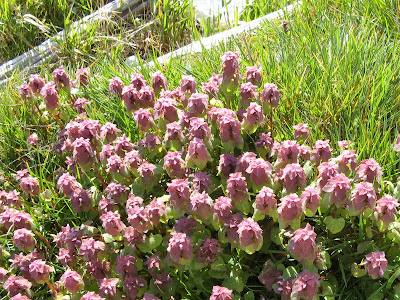 |
| My five year old cedar in its new pot. |
We have small trees in pots on the front deck. We start with plant two year old seedlings. It's either the water, sun, fertilizer, or tender loving care that makes them outgrow their containers in just a few years.
Two cedar trees have been sharing my rectangular pots with flowers from spring to fall. Now the trees make too much shade, and their roots have taken over the limited soil.

I got two larger pots free with
Canadian Tire money. They are pottery coloured, but made of plastic. We need to limit weight on the deck.

I waited until spring to transplant so the trees would start their new growth in their new homes. The alternative was in the fall, but I didn't want to disturb my remaining flowers.
You can see that the scale-like cedar leaves are still sporting their winter brown. That's a hint that it's a good time for transplanting. The tree is still dormant.

To help keep the soil light in the pot, I purchase a bag of
Vigoro Perlite to combine with potting soil. The Perlite reduces weight, but it also provides for soil aeration, helps prevent soil compaction, and foster root growth, just what I am looking for.
Wayne drilled holes in the bottom of my pot and I placed a few rocks in the bottom. This will help keep the soil from blocking the drain holes. It will also help keep the weight at the bottom, hopefully helping to keep the pot from blowing off the deck.

I put a layer of potting soil over the rocks, a layer of Perlite, and more potting mix. I mixed them together and made a hole for the roots.
The hardest part was getting the trees out of their former pots. They were root bound.
Once the tree were in place, I filled in with potting soil. I staked the trees, and surrounded the trunks with more rocks. The rocks look good, add weight, and keep the soil from drying out.
 |
| My other cedar tree with its driftwood windbreak. |
What happened to the flower pots? Of course, I went out and found two more two year old cedars to start the process all over again.
Do you have trees in pots? How often do you have to transplant them? -- Margy
 Unlike most plants, the Pine Sap (Monotropa hypopithys) does not contain chlorophyll to convert sunlight into energy. The Pinesap gets its nutrients from organic matter in the soil and is a parasite of plant roots (much like the Vancouver Groundcone). It flowers from June through October. In the summer, the blooms tend to be yellow and in the fall, they tend to be more reddish. As you can see, mine is the summer variety.
Unlike most plants, the Pine Sap (Monotropa hypopithys) does not contain chlorophyll to convert sunlight into energy. The Pinesap gets its nutrients from organic matter in the soil and is a parasite of plant roots (much like the Vancouver Groundcone). It flowers from June through October. In the summer, the blooms tend to be yellow and in the fall, they tend to be more reddish. As you can see, mine is the summer variety. For plant identification I like to use Plants of Coastal British Columbia by Jim Pojar and Andy MacKinnon. It includes trees, shrubs, wildflowers, aquatics, grasses, ferns, mosses, lichens and, of course, some oddball plants like the Pine Sap. -- Margy
For plant identification I like to use Plants of Coastal British Columbia by Jim Pojar and Andy MacKinnon. It includes trees, shrubs, wildflowers, aquatics, grasses, ferns, mosses, lichens and, of course, some oddball plants like the Pine Sap. -- Margy


























































